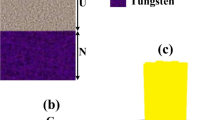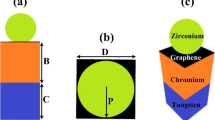Abstract
The developed design invention is proposed in three different types of materials: zirconium (Zr) in a resonator, indium antimonide (InSb) for the substrate, and tungsten (W) developed for the ground section effectively. To indicate the high rates (absorptions) in the developed output line, the wavelengths (in µm) of 0.2, 0.5, 0.75, and 1.5 have been used. The proposed absorber can be investigated in the four regions of the atmosphere (UV area, visible spectrum, near and also middle infrared regions) perfectly. With the development of the wavelengths (µm) and band rates (nm) on the overall range, 97% can be verified with 500 nm bandwidth by 0.2 and 0.7 µm wavelength deviation, and 95.24% by 1150 nm (bandwidth) between 1.74 and 2.89 wavelength values, respectively. The main validation of the design (2800 nm) band rate performs 93.46% from ultraviolet to MIR spectrum. To indicate the current work’s performance effectively, the various sections are also included as the improved absorbed lines by the develo** steps of the absorber and the configuration of design in different views with the labels of used materials and numerical parameters in the first section of “Design and Parameters”. After the performance of an investigation of the design, the analyzed values of all used parameters (Zr resonator, InSb substrate, tungsten ground, design width, cylinder radius, and effective chemical potential values) are shown with output absorption lines and color graph. Moreover, to study the polarization, incident angles (degree) performing are also included in “Results and Discussions”. The renewable energy applications of the proposed solar design can be performed in heat storage to support industrial heat such as drying, metal heating, and fluid heating. Moreover, the absorber can also be used for photovoltaic applications (solar electricity, solar heating) and heating applications (water heating).










Similar content being viewed by others
Availability of Data and Materials
The data supporting the findings in this work are available from the corresponding author with reasonable request.
References
Jeffry L, Ong MY, Nomanbhay S, Mofijur M, Mubashir M, Show PL (2021) Greenhouse gases utilization: a review. Fuel. https://doi.org/10.1016/j.fuel.2021.121017
Kumar L, Hasanuzzaman M, Rahim NA (2019) Global advancement of solar thermal energy technologies for industrial process heat and its future prospects: a review. Energy Convers Manage 195:885–908. https://doi.org/10.1016/j.enconman.2019.05.081
Hassen A (2021) Analysis of dairy value chain: the case of Haramaya Woreda, East Hararghe Zone Oromia Region, Ethiopia. Front Neurosci 14(1):1–13
Fath HES (1998) Technical assessment of solar thermal energy storage technologies. Renew Energy 14(1–4):35–40. https://doi.org/10.1016/s0960-1481(98)00044-5
Veteran DKU, Yogyakarta Y (2021) Pembentukan peraturan perundang-undangan. Front Neurosci 14(1):1–13
Abbott D (2010) Kee** the energy debate clean: How do we supply the world’s energy needs? Proc IEEE 98(1):42–66. https://doi.org/10.1109/JPROC.2009.2035162
Bond JC, Lauretta DS, O’Brien DP (2010) Erratum to Making the Earth: combining dynamics and chemistry in the Solar System[Icarus, 205, (2010), 321–337]. Icarus 208(1):504. https://doi.org/10.1016/j.icarus.2010.04.001
Liu Z, Mohammadzadeh A, Turabieh H, Mafarja M, Band SS, Mosavi A (2021) A new online learned interval type-3 fuzzy control system for solar energy management systems. IEEE Access 9:10498–10508. https://doi.org/10.1109/ACCESS.2021.3049301
Byamukama M, Bakkabulindi G, Akol R, Sansa-Otim J (2019) New techniques for sizing solar photovoltaic panels for environment monitoring sensor nodes. J Sensors. https://doi.org/10.1155/2019/9835138
Patel SK, Parmar J, Katkar V (2022) Ultra-broadband, wide-angle plus-shape slotted metamaterial solar absorber design with absorption forecasting using machine learning. Sci Rep. https://doi.org/10.1038/s41598-022-14509-y
Kabeel AE (2007) Water production from air using multi-shelves solar glass pyramid system. Renew Energy 32(1):157–172. https://doi.org/10.1016/j.renene.2006.01.015
Watts RA, Smith J, Thomson A (2016) The design and installation of solar home systems in rural Cambodia. J Humanit Eng. https://doi.org/10.36479/jhe.v4i2.57
Hoffmann C (2007) Sanierung als zweite Chance: Strategien für ein angenehmes Raumklima ohne aktive Kühlung in Bürogebäuden Mitteleuropas (Doctoral dissertation, Verlag nicht ermittelbar)
Chakrabarty S, Islam T (2011) Financial viability and eco-efficiency of the solar home systems (SHS) in Bangladesh. Energy 36(8):4821–4827. https://doi.org/10.1016/j.energy.2011.05.016
Košičan J, Pardo MÁ, Vilčeková S (2020) A multicriteria methodology to select the best installation of solar thermal power in a family house. Energies. https://doi.org/10.3390/en13051047
Axaopoulos PJ, Fylladitakis ED (2013) Performance and economic evaluation of a hybrid photovoltaic/thermal solar system for residential applications. Energy Build 65:488–496. https://doi.org/10.1016/j.enbuild.2013.06.027
Huide F, Xuxin Z, Lei M, Tao Z, Qixing W, Hongyuan S (2017) A comparative study on three types of solar utilization technologies for buildings: photovoltaic, solar thermal and hybrid photovoltaic/thermal systems. Energy Convers Manage 140:1–13. https://doi.org/10.1016/j.enconman.2017.02.059
Wu J, Yan X, Yuan X, Zhang Y, Zhang X (2021) A dual-tunable ultra-broadband terahertz absorber based on graphene and strontium titanate. Results Phys 31:105039. https://doi.org/10.1016/j.rinp.2021.105039
Wang J et al (2021) High-performance spectrally selective absorber using the ZrB2-based all-ceramic coatings. ACS Appl Mater Interfaces 13(34):40522–40530. https://doi.org/10.1021/acsami.1c08947
Wang J et al (2021) An ultra-high temperature stable solar absorber using the ZrC-based cermets. Front Energy Res. https://doi.org/10.3389/fenrg.2021.787237
Cheng Y, Li Z, Cheng Z (2021) Terahertz perfect absorber based on InSb metasurface for both temperature and refractive index sensing. Opt Mater (Amst). https://doi.org/10.1016/j.optmat.2021.111129
Almawgani AHM, Han BB, Patel SK, Armghan A, Alabsi BA, Taya SA (2023) Design of surface plasmon resonance–based solar absorber using bloom-shaped Au-InSb-Al structure. Plasmonics. https://doi.org/10.1007/s11468-023-02003-8
Gao P et al (2023) Multifunctional and dynamically tunable coherent perfect absorber based on InSb and graphene metasurface. Results Phys. https://doi.org/10.1016/j.rinp.2023.106797
Hu Z, Qiu Y, Li Q, Wang J, Xu M (2022) Tungsten nanopore-based near-ideal spectral selective solar absorber for a wide temperature range. Sol Energy 248:149–159. https://doi.org/10.1016/j.solener.2022.11.003
Wang J, Liang Y, Huo P, Wang D, Tan J, Xu T (2017) Large-scale broadband absorber based on metallic tungsten nanocone structure. Appl Phys Lett. doi 10(1063/1):5004520
Cheng Y et al (2021) Ultra-broadband perfect solar energy absorber based on tungsten ring arrays. Eng Res Express. https://doi.org/10.1088/2631-8695/ac372f
Karki B, Uniyal A, Sarkar P, Pal A, Yadav RB (2023) Sensitivity improvement of surface plasmon resonance sensor for glucose detection in urine samples using heterogeneous layers: an analytical perspective. J Opt. https://doi.org/10.1007/s12596-023-01418-0
Karki B, Pal A, Sarkar P, Yadav RB, Muduli A, Trabelsi Y (2024) ZnO-silicon enhanced surface plasmon resonance sensor for chemical sensing. SILICON. https://doi.org/10.1007/s12633-024-02973-2
Lashgari HR, Chu D, **e S, Sun H, Ferry M, Li S (2014) Composition dependence of the microstructure and soft magnetic properties of Fe-based amorphous/nanocrystalline alloys: a review study. J Non-Cryst Solids 391:61–82. https://doi.org/10.1016/j.jnoncrysol.2014.03.010
Liu CT et al (1998) Test environments and mechanical properties of Zr-base bulk amorphous alloys. Metall Mater Trans A Phys Metall Mater Sci 29(7):1811–1820. https://doi.org/10.1007/s11661-998-0004-6
Plissard SR et al (2013) Formation and electronic properties of InSb nanocrosses. Nat Nanotechnol 8(11):859–864. https://doi.org/10.1038/nnano.2013.198
Massidda S, Continenza A, Freeman AJ, De Pascale TM, Meloni F, Serra M (1990) Structural and electronic properties of narrow-band-gap semiconductors: InP, InAs, and InSb. Phys Rev B 41(17):12079–12085. https://doi.org/10.1103/PhysRevB.41.12079
Nasution RA (2021) Analisis persepsi pedagang pada penggunaan qris sebagai alat transaksi umkm di kota medan. Front Neurosci 14(1):1–13
Eroshenko A et al (2022) Effect of deformation processing on microstructure and mechanical properties of Ti-42Nb-7Zr alloy. Obrab Met 24(4):206–218. https://doi.org/10.17212/1994-6309-2022-24.4-206-218
Gomaa HM, Yahia IS, Zahran HY (2021) Correlation between the static refractive index and the optical bandgap: review and new empirical approach. Phys B Condens Matter. https://doi.org/10.1016/j.physb.2021.413246
Liu JG, Ueda M (2009) High refractive index polymers: fundamental research and practical applications. J Mater Chem 19(47):8907–8919. https://doi.org/10.1039/b909690f
** JQ et al (2007) Optical thin-film materials with low refractive index for broadband elimination of Fresnel reflection. Nat Photonics 1(3):176–179. https://doi.org/10.1038/nphoton.2007.26
Kumar Laha S, Kumar Sadhu P, Ganguly A, Kumar Naskar A (2022) A comparative study on thermal performance of a 3-D model based solar photovoltaic panel through finite element analysis. Ain Shams Eng J. https://doi.org/10.1016/j.asej.2021.06.019
Solís-Santomé A et al (2019) Conceptual design and finite element method validation of a new type of self-locking hinge for deployable CubeSat solar panels. Adv Mech Eng. https://doi.org/10.1177/1687814018823116
Ross RT, Nozik AJ (1982) Efficiency of hot-carrier solar energy converters. J Appl Phys 53(5):3813–3818. https://doi.org/10.1063/1.331124
Li Y et al (2013) Cobalt phosphate-modified barium-doped tantalum nitride nanorod photoanode with 1.5% solar energy conversion efficiency. Nat Commun. https://doi.org/10.1038/ncomms3566
Brey L, Fertig HA (2006) Electronic states of graphene nanoribbons studied with the Dirac equation. Phys Rev B Condens Matter Mater Phys. https://doi.org/10.1103/PhysRevB.73.235411
Bao WS, Liu SY, Lei XL, Wang CM (2009) Nonlinear dc transport in graphene. J Phys Condens Matter. https://doi.org/10.1088/0953-8984/21/30/305302
Chen J et al (2022) Broadband, wide-incident-angle, and polarization-insensitive high-efficiency absorption of monolayer graphene with nearly 100% modulation depth at communication wavelength. Results Phys. https://doi.org/10.1016/j.rinp.2022.105833
Agravat D, Patel SK, Almawgani AHM, Alsuwian T, Armghan A, Daher MG (2023) Investigation of a novel graphene-based surface plasmon resonance solar absorber to achieve high absorption efficiency over a wide spectrum of wavelengths, from ultraviolet to infrared. Plasmonics. https://doi.org/10.1007/s11468-023-02061-y
Patel SK, Agravat D, Alsalman O, Surve J, Taya SA, Parmar J (2023) Numerical analysis of wideband solar absorber using thick film with glassy material, resonator and back reflector. Opt Quantum Electron 55(9):754. https://doi.org/10.1007/s11082-023-04982-8
Liu Z et al (2019) Truncated titanium/semiconductor cones for wide-band solar absorbers. Nanotechnology. https://doi.org/10.1088/1361-6528/ab109d
Rangasamy S, Khansadurai AM, Venugopal G, Udayakumar AK (2023) Graphene-based O-shaped metamaterial absorber design with broad response for solar energy absorption. Opt Quantum Electron. https://doi.org/10.1007/s11082-022-04315-1
Yu P et al (2019) A numerical research of wideband solar absorber based on refractory metal from visible to near infrared. Opt Mater (Amst). https://doi.org/10.1016/j.optmat.2019.109400
Patel SK et al (2023) Design of a broadband solar absorber based on Fe2O3/CuO thin film absorption structure. Opt Quantum Electron. https://doi.org/10.1007/s11082-023-04706-y
Obaidullah M, Esat V, Sabah C (2021) Multi-band (9,4) chiral single-walled carbon nanotube based metamaterial absorber for solar cells. Opt Laser Technol. https://doi.org/10.1016/j.optlastec.2020.106623
Wu P, Dai S, Zeng X, Su N, Cui L, Yang H (2023) Design of ultra-high absorptivity solar absorber based on Ti and TiN multilayer ring structure. Int J Therm Sci. https://doi.org/10.1016/j.ijthermalsci.2022.107890
Agravat D, Patel SK, Almawgani AHM, Irfan M, Armghan A, Taya SA (2023) Graphite-based surface plasmon resonance structure using Al2O3-TiO2-ZrO2 materials for solar thermal absorption. Plasmonics. https://doi.org/10.1007/s11468-023-01986-8
Acknowledgements
The authors extend their appreciation to the Deputyship for Research & Innovation, Ministry of Education in Saudi Arabia for supporting this research work through the project number 375213500.
Funding
The authors extend their appreciation to the Deputyship for Research & Innovation, Ministry of Education in Saudi Arabia for supporting this research work through the project number 375213500.
Author information
Authors and Affiliations
Contributions
Conceptualization, S.K.P and B.B.H.; methodology, A.R.B, B.B.H, and K.P.R.; software, A.R.B, B.B.H., S.K.P. and K.P.R.; investigation, A.A and Y.S.A.; formal analysis, all authors; writing—original draft preparation, all authors; writing—review and editing, all authors; all authors have read and agreed to the published version of the manuscript.
Corresponding author
Ethics declarations
Ethical Approval
Not applicable.
Competing Interests
The authors declare no competing interests.
Additional information
Publisher's Note
Springer Nature remains neutral with regard to jurisdictional claims in published maps and institutional affiliations.
Rights and permissions
Springer Nature or its licensor (e.g. a society or other partner) holds exclusive rights to this article under a publishing agreement with the author(s) or other rightsholder(s); author self-archiving of the accepted manuscript version of this article is solely governed by the terms of such publishing agreement and applicable law.
About this article
Cite this article
Boudabbous, A.R., Han, B.B., R., K.P. et al. Graphene-based Multilayer Surface Plasmon Resonance Solar Absorber in the UV to MIR Region for Renewable Energy Application. Plasmonics (2024). https://doi.org/10.1007/s11468-024-02399-x
Received:
Accepted:
Published:
DOI: https://doi.org/10.1007/s11468-024-02399-x




